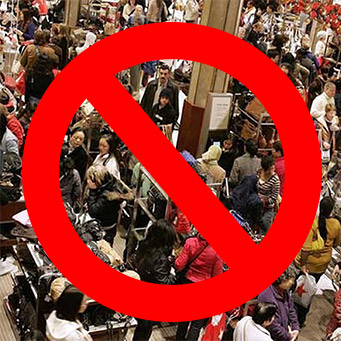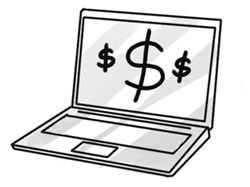We finished our BUY NOTHING MONTH! What is that, you say? It’s a 4-week period of time in which we reject consumerism, stuff our pockets full of saved cash and fly off into the sunset in our roflcopter (pre-owned and paid off, of course).
Advertising has us chasing cars and clothes, working jobs we hate so we can buy shit we don’t need.
– Tyler Durden, Fight Club
Words to live by. Buy Nothing Month resets your spending and makes you question everything you normally mindlessly whip out a credit card for. And, at the end, you have a big pile of money to do whatever you want with. If you’re earning a decent wage but just can’t seem to make ends meet, try this experiment. It’s so easy: you don’t even have to do anything. In fact, not doing things is the whole point.
Our Buy Nothing Month budget:
- $50/week budget for groceries – essentials only, no treats
- Gasoline fill-ups – it’s tough to compromise on gasoline, but we went nowhere except to and from the office
- NOTHING ELSE!
Saving on Groceries
$50/week for two adults should be reasonable – but our grocery spending had crept into the $75-$100/week range in January. What’s up with that?
Turns out, it was mostly mid-winter indulgences like expensive cereals and chocolates (which will, of course, just be weight we wish we could lose come June). We agreed to not buy any of those things in February and stuck with the essentials: fresh vegetables, bread, and eggs. For meat, we cleaned out our freezer.
The Freezer Diet
We also paired “Buy Nothing Month” with what we like to call a “Freezer Diet” – ie: eat all the stuff in the freezer. Any time the Safeway prizing wizards decide it’s time to put meat on sale I snap it up like a hungry vulture and stuff it into my freezer to get us through the weeks when Safeway prices the meat high. By thawing and eating our stockpile, our freezer went from overstuffed to half empty. By eating what we had already paid for we saved a bundle on February’s groceries – about $20-25 off each week (we eat a lot of meat).
For Valentine’s Day we grilled most of the meats we had stuffed away in the freezer. This gave us about 2 weeks worth of tasty, tasty meats:
Our Grocery Outlet adventure
Our $50 a week food goal also inspired us to seek out a new grocery store. We drove over to Grocery Outlet and discovered that they sell the same 10 lb bag of chicken breasts we buy at Safeway for half the price: $5 instead of $10. Alas, the rest of the store didn’t carry much of what eat on a weekly basis (plenty of treats like Cheez-It and cookies, though). The frozen vegetable selection was lacking, and the fresh stuff didn’t look so hot, so we probably won’t be back except for a few bags of chicken every once in a while.
Nonetheless, it was good to take a trip outside of our “comfort zone” and see just how much Safeway marks things up. I really hate Safeway’s arcane pricing: some weeks a thing is $2.50, other weeks it’s $3.50, and there’s no real reason why! It’s not like there’s a supply shortage, it’s just some B.S. they use to milk a few extra dollars out of every shopper. I know what the lowest price is on our regular purchases and I keep enough on hand to skate through the weeks where things aren’t on sale. Either way, knowing that another store nearby sells the same thing for a few dollars less made me not want to buy it at Safeway – money saved!
Cutting back on treats
As an additional sacrifice, I quit buying fruit for the entire month. I usually buy about $6-$10 worth of fruit every week – mostly strawberries and blueberries, which I eat as snacks. Turns out, I didn’t even miss ’em. Strawberries are crazy expensive in February, and I pocketed about $35 by skipping them for the month. I figure I still get plenty of vitamins through all the veggies I eat, so a month without this treat isn’t exactly going to give me rickets.
We also didn’t buy any cereals, chocolate, or other treats. We have some left over from the holidays, and this stuff just makes us fat, anyway – lol.
We don’t buy soda, coffee, or booze, but if you’re doing a Buy Nothing Month those are also easy things to cut.
Trying new foods
Beans are like a buck a bag and offer pretty complete nutrition. I wouldn’t make beans the only thing I eat, of course, but an inexpensive protein would be nice to add to the rotation instead of eating pricey meats every day.
Well, I never had beans growing up and I assumed I didn’t like them. I was wrong – beans can be pretty good as long as they don’t get overcooked into grainy mush. Jim likes beans, so he and I went on a bean adventure in Buy Nothing Month. I tried lentils, black beans, and red kidney beans – mixed with rice, mixed with vegetables, and as a straight-up side dish. I need some more time to truly develop my love for them, but I could see beans becoming a household staple.
Seeking out Savings
Clamping down on spending also inspired us to seek out unnecessary spending. I didn’t expect to find anything – after all, we run a tight financial ship here… or so I thought.
Deleting doubled-up services
We made a huge discovery this month: Jim was still paying for his own separate web hosting!
With both of our hosting accounts offering unlimited storage there was no reason to have two hosting accounts. This was tough to track down because we buy hosting in 2 year blocks from Lunarpages, so the bill only comes around every other year.
We both thought it was my hosting being billed every time the bill came around.We canceled his hosting, moved everything to mine, and transferred his domain for $10 over to Dynadot from Lunarpages. Spending $10 to save $250 every other year sounds like a good deal to me, so we bought the domain transfer. We got together like, 8 years ago. It pains me to think that for over five years we paid for hosting we didn’t need to be paying for.
Alternatives to current services
I also tried Carbonite, a $60/year alternative to Mozy which is the online backup solution I normally use and pay $250/year for. I’m very happy with Mozy, but I wouldn’t mind paying $60 instead of $250!
Unfortunately, Carbonite didn’t work on my system. I’m on Windows 7 and it slowed Windows Explorer down to a crawl. Every time I right clicked the Start button or inside a folder on my hard-drive I had to wait through a 3-4 second pause before the context menu appeared. This slow-down survived restarts, reinstalls, everything. I gave up, uninstalled Carbonite, and my computer returned to the lightning fast speed I built it for. I guess with online backup services you get what you pay for. Failed experiment, but I’m glad I tried.
Itemized our taxes
Eyeballs… glazing… over. I know… but it saved us several hundred bucks. In previous years we took the standard deduction and ran, but this year our property tax was enough to force us to itemize. We dug up old receipts and took the nuanced approach to this year’s taxes and pocketed a few hundred bucks.
Switched to a better rewards credit card
As if that wasn’t enough, we dumped our American Express Starwood Preferred Guest card on account of its rewards being too sucky for us (you can read more about that here) and switched to the American Express Fidelity Investment Rewards card. Now we spend money on the card and get 2% cash back deposited directly into an investment account. 2% cash back is nuts – imagine spending $1,000 and getting $20 IN CASH – not points, not fancy hotels, not gift cards to exotic boutique stores – all for doing nothing.

Click here to go to Fidelity’s site and learn more about the very awesome 2% cash back Fidelity Investment Rewards card
I like getting paid for doing nothing. Too bad we didn’t spend much this month – hah.
Cheap entertainment
We’re very lucky to live in the Pacific Northwest where we’re able to walk outside pretty much year round (especially in February while everyone back home in the Midwest was buried under ten feet of snow). If you live somewhere nice, walking is some of the best free entertainment I know of. If you’re lucky you’ll get to see some crazy stuff, too, like a dude practicing yoga on a fountain or a mess of ducks fighting over bread slices thrown into the water by a toddler.
We made a point of not going to the movie theater, not buying the latest issues of Saga (this was actually painful, I love this series and am dying to know what happens next), and not going to any events. In the evenings we worked on our personal projects or watched Doctor Who (I love this show more than is probably considered healthy – you can see my Doctor Who fan art here).
Jim discovered Kindle book borrowing on Amazon, and he’s so enamored with it he’s declared that he never needs to buy another book again (we’ll see ;) ).
And, as I said earlier, we spent Valentine’s Day (well, the Saturday after) barbecuing meats we already had instead of eating at a crowded restaurant with jacked-up V-Day prices.
Total Spending
We spent a grand total of $380 in February. This all went into food and a domain transfer. The rest was the usual mortgage, electricity, gas, city garbage, and water. We had a sizable amount of money left over, which was shuttled off into our Vanguard investment funds.
Did we just get lucky?
To some extent, yes. After all, our range oven didn’t start sparking in February (no, it did that in March) and nothing fell off our nearly-90k-mile car (knock on wood). But by aggressively cutting discretionary spending, Buy Nothing Month gave us an above-average amount of savings in February to sock away for some future time when it might be needed.
But this isn’t sustainable!
Of course it’s not – but after four weeks of carefully considering everything you buy (or simply going without), it’s much easier to reject unnecessary purchases in the days and weeks that follow. Just like a diet, it doesn’t work if you diet for 4 weeks and then overeat when the 4 weeks are done.
What can YOU stop buying?
If you only spent $380 plus your usual mortgage/rent/utilities payments, how much would you have left over? Probably more than you usually do. That’s why a Buy Nothing Month is so awesome!
Pretend you just lost your job and you’ve only got enough for simple food and your rent/mortgage. That’ll get you in the right mindset for a Buy Nothing Month. You can go a month without:
- Meals out
- Anything from Whole Foods
- Candy / snacks / soda
- Movie tickets
- Traveling anywhere
- Home decor
- Clothing & shoes unless the soles just fell off your very last pair
- Personal appearance stuff like whatever voodoo happens inside salons
- Knick-nacks / toys
- Look for places to cut spending – phone line, TV service, texting plan, etc
Tell us about your own Buy Nothing experiments – even if it’s just for a day or a week, not buying stuff can have a huge impact!



























